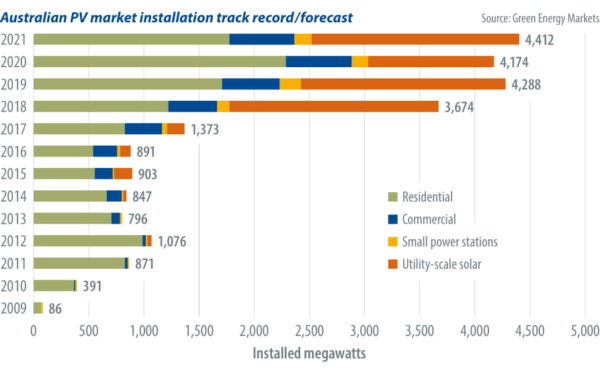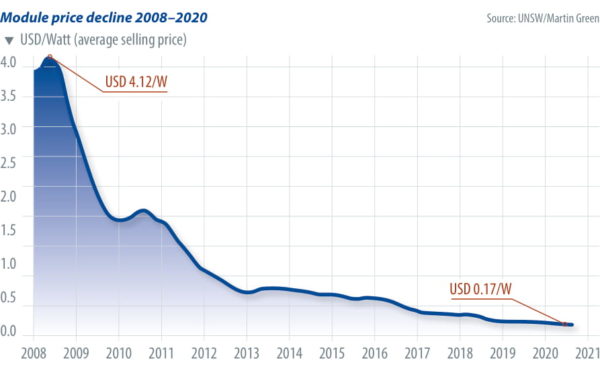Australia is a land of contrasts. Its population is strongly pro-renewables and embracing rooftop PV at a rate faster than anywhere in the world, but the nation is led by a government hell-bent on stemming the energy transition and locking in fossil fuels for as long as possible.
Consider the grassroots support for solar. Today 21% of Australian households – more than 2.4 million households – are benefitting from PV systems and the cheaper electricity they deliver. In all, 10 GW of solar is on Australian roofs, which equals around 5% of national generation, and rising. It is estimated that by 2032, when Australia’s largest coal generator of 2.9 GW is decommissioned, rooftop solar PV will have reached a staggering 30 GW.
Some are boldly predicting that even this is conservative, given the insatiable demand for PV during Australia’s harsh lockdown measures resulting from the pandemic. Industry analyst SunWiz has clocked the meteoric rise of rooftop PV at 40% over last year, reaffirming the thirst for home solar and cheaper energy.
Blocking policy
Yet the government of the day – one that has no energy policy, no renewable energy target and ineffective, vague emissions reduction strategies – is determined to lock in fossil fuels for the foreseeable future. In its latest science-denying move, the government is promoting a gas-led economic recovery and development of a taxpayer-funded AUD 52 billion (US$37 billion) 1 GW gas-fired power plant.
The coalition appears to have reached the conclusion it cannot win on coal and is now turning to gas as the “solution” but in reality it is just a ploy to try and hold back the renewables tide. Nobody else in the world is advocating spending billions building a gas plant that becomes a stranded asset in a matter of years.
Not the Commonwealth Scientific and Industrial Research Organisation (CSIRO), which labels gas generation as expensive. Nor scientists who recognize a new gas plant in 2021 for what it is: out of kilter with Paris climate goals. Not economists, who point to the dearth of jobs created by gas. The list goes on, with investors saying the economics don’t stack up, and environmentalists are aghast.
A member of the Intergovernmental Panel on Climate Change panel has declared gas turbines slow and inefficient compared to modern battery technology. And it is not even clear if private sector investors will back the plan.
In short, the broader community is incredulous. Together with business and industry, the Australian Energy Market Operator (AEMO) knows we need to put the lid on gas generation. But the government is instead putting businesses and the Australian economy at risk, by saddling them with exorbitant costs and creating stranded assets. All at a key time in which we need to stop polluting and warming the planet and instead quickly decarbonize energy, industry and transport.
Well-informed pv magazine readers will know that the world needs to cut emissions 7.6% each year for a decade to contain warming to 1.5 C. Australia’s trajectory is woefully inadequate. Last year saw a 0.3% rise in carbon emissions, overshooting the target by 7.9%.

Plundering, polluting
Australia’s conservative government is out of step with the core conservative mission to foster competition through free market forces and create jobs and prosperity for perpetuity.
People often ask how the will of the people will win. The answer lies in the tide of economics and action already swamping fossil fuel interests. Today, the cost of building a new PV plant is 58% cheaper than new coal and 44% cheaper than new gas. And new solar and wind will never be subject to a carbon price.
Nor will the wind or the sun ever be depleted. Australia is blessed with some of the best renewable energy resources in world. We have vast stretches of uninhabited land, much of it desert, awash with sunlight and strong winds throughout the year. Our energy export infrastructure places us at a huge advantage for embedding renewable energy to power the manufacture and refining of steel, aluminum, glass and concrete and green hydrogen.
I believe we will get there. Back in 2008 when I was appointed chief executive of the Smart Energy Council there were just 7,000 solar PV systems on Australian households (primarily those of technology pioneers), and battery storage technology was barely a blink on the radar.
Since then the price of PV modules has declined a staggering 94%. World renowned Australian PV researcher Martin Green, who has been pivotal in PV cell advances, charts the wholesale cost of a watt of solar PV at $6.50 in 2008 dropping to just $0.21/W today. He confidently predicts a “credible trajectory” to $0.10/W.

Back in 2008 had we presented this picture of 2020 even the most optimistic would have been incredulous. So, are we on track? The Smart Energy Council remains resolute in its determination to do what is right for the people, our economy and the planet, and to continue to call out irrational, irresponsible actions.
Australia’s conservative coalition government is but a king on the shore demanding the tide to not come in. Their position is untenable in the long term. They stand on the wrong side of
history.

Image: Smart Energy Council
Author: John Grimes
About the author: John Grimes is the chief executive of the Smart Energy Council (SEC). Based in Canberra, the SEC is the peak body committed to the accelerated transition to a sustainable, renewable-energy future. With a network of 26,000 people, the nonprofit organization is a strong renewable-energy advocate. It presents conferences, summits, training and technical materials related to solar and wind power, battery storage, and green hydrogen. The council is actively campaigning for climate action and renewables-led economic recovery through greater investment in renewables. There are numerous benefits: significant private and public investment, hundreds of thousands of secure jobs, greater prosperity, cheaper power prices, guaranteed sustainability and a much more climate-friendly future.
This content is protected by copyright and may not be reused. If you want to cooperate with us and would like to reuse some of our content, please contact: editors@pv-magazine.com.
